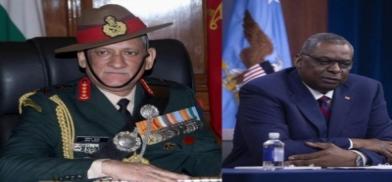India’s top general discusses multilateral defence cooperation with US Defense Secretary
India’s Chief of Defense Staff, General Bipin Rawat, in what is being termed as a “historic meeting” with US Defence Secretary Lloyd Austin, discussed expanding multilateral cooperation with regional partners, according to Defence Department Spokesperson John Kirby

India’s Chief of Defense Staff, General Bipin Rawat, in what is being termed as a “historic meeting” with US Defence Secretary Lloyd Austin, discussed expanding multilateral cooperation with regional partners, according to Defence Department Spokesperson John Kirby.
“This historic meeting highlights the enduring strength of the US-India Major Defense Partnership as the two countries work in concert with like-minded partners to sustain a free and open Indo-Pacific,” Kirby said.
Rawat's first visit to the Pentagon came a week after a meeting between Prime Minister Narendra Modi and US President Joe Biden and the Quad summit of Modi, Biden and Prime Ministers Scott Morrison of Australia and Yoshihide Suga, of Japan in Washington.
Kirby said, in a pointed reference, that at their meeting on Thursday Austin underscored the US commitment to supporting the Indian Armed Forces’ “transition toward greater institutional integration and operational jointness.”
That refers to the ability of the armed forces and their equipment to operate together. While discussing increasing military cooperation between their countries, they considered priorities in new defence areas like space, cyber, and emerging technologies, he said.
“They also discussed opportunities for expanding multilateral cooperation with regional partners,” he said.
In their joint statement, Modi and Biden “reaffirmed the strength of the defence relationship between the United States and India and the unwavering commitment to India as a Major Defence Partner.”
They listed "defence information sharing, sharing of logistics and military-to-military interactions, strengthening cooperation in advanced military technologies, and expanding engagements in a multilateral framework including with regional partners” among areas they would work together.
At the summit held under the shadow of growing aggressive stance by China in the India-Pacific region, the leaders said, “We recommit to promoting the free, open, rules-based order, rooted in international law and undaunted by coercion, to bolster security and prosperity in the Indo-Pacific and beyond.”
Although the four countries have shied away from a formal military alliance, they have been holding joint naval exercises.
The US, Australia and the United Kingdom formed a defence pact last month.
Biden and Modi said that they looked forward to the inaugural meeting of the Industrial Security Agreement (ISA) summit for high-end defence industrial collaboration drawing on the "innovation and entrepreneurship in defence industries for co-development, co-production and expanding mutual defence trade.
The weeklong ISA summit concluded in New Delhi on Friday with an agreement to establish the Indo-US Industrial Security Joint Working Group.
India's Press Information Bureau said, “This group will meet periodically to align the policies and procedures expeditiously that will allow the defence industries to collaborate on cutting edge defence technologies.”
Anurag Bajpai, joint secretary in the Department of Defence Production, and David Bagnati, the assistant director at the Defence Technology Security Administration, led their sides at the summit.
In the series of visits high-level by defence officials after Biden took office that began with a trip to India by Austin, Vice-Admiral G. Ashok Kumar, India's Vice Chief of Naval Staff, came to the US in June.
He met with Vice Admiral Steve Koehler, the commander of the US 3rd Fleet that operates in the Indo-Pacific.
The US Navy quoted Koehler as saying, “The US-India strategic partnership is one of our most critical relationships in the Indo-Pacific. Open discussion of shared and complementary capabilities not only strengthens our relationship, it increases our naval effectiveness as we work together to ensure a free and open Indo-Pacific.”









Post a Comment